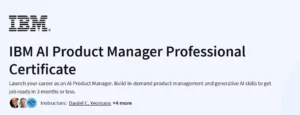What will you learn in Building a Machine Learning Pipeline from Scratch Course
Design a production-ready ML pipeline following software-engineering best practices
Structure pipeline code with clear directory layouts, dependency management, and configuration files
Use Directed Acyclic Graphs (DAGs) to orchestrate data and training workflows
Build reusable library modules for data loading, model training, and report generation
Program Overview
Module 1: Course Goals & Structure
⏳ 10 minutes
Topics: Intended audience; course goals; structure & strengths
Hands-on: Review course roadmap and objectives
Module 2: Getting Started
⏳ 15 minutes
Topics: Why pipelines vs. notebooks; defining ML training pipelines
Hands-on: Complete the “Getting Started” quiz
Module 3: Structuring the ML Pipeline
⏳ 30 minutes
Topics: System architecture; directory layout; code organization; dependency management
Hands-on: Scaffold a project directory and initial files
Module 4: Directed Acyclic Graphs (DAGs)
⏳ 20 minutes
Topics: DAG fundamentals; topological sorting
Hands-on: Implement and sort a DAG for sample pipeline tasks
Module 5: Building the ML Library
⏳ 45 minutes
Topics: OOP modules; OmegaConf configurations; abstract base classes; datasets; models; reports
Hands-on: Create library components and configuration schemas
Module 6: The Pipeline Core
⏳ 45 minutes
Topics: CLI parsing (argparse); experiment tracking; logging; docstrings
Hands-on: Assemble top-level pipeline script with logging and tracking
Module 7: Extending the Pipeline
⏳ 30 minutes
Topics: Adding support for new datasets and model types
Hands-on: Extend pipeline to a second dataset
Module 8: Testing
⏳ 30 minutes
Topics: Unit testing; pytest; system testing
Hands-on: Write and execute tests for pipeline functions
Get certificate
Job Outlook
Median annual wage for data scientists in the U.S.: $112,590
Projected employment growth: 36% from 2023 to 2033
Roles include ML Engineer, Data Scientist, and MLOps Engineer in tech, finance, and healthcare
Strong demand for end-to-end pipeline skills in startups and enterprises
Specification: Building a Machine Learning Pipeline from Scratch Course
|
FAQs
- Pipelines can be adapted to process streaming data with frameworks like Apache Kafka or Spark Streaming.
- Real-time logging and monitoring can track model performance continuously.
- DAG-based orchestration supports incremental data processing.
- Alerts and automated retraining can be triggered by data anomalies.
- Enables production-ready systems for finance, IoT, or online analytics applications.
- Unit testing ensures individual modules like data loaders or model trainers work correctly.
- System testing validates the entire pipeline end-to-end.
- Pytest integration allows automated and repeatable tests.
- Detects edge cases and prevents silent failures in production.
- Enhances confidence in deploying ML models to real-world environments.
- Modular library design allows plugging in new model types easily.
- Supports ensemble strategies for better predictive performance.
- CLI parsing enables dynamic selection of models at runtime.
- Can handle different datasets simultaneously in a structured workflow.
- Encourages maintainable and scalable ML systems for enterprise projects.
- DAGs define clear dependencies between data preprocessing, training, and evaluation steps.
- Topological sorting ensures tasks run in correct order automatically.
- Simplifies debugging and visualization of pipeline execution.
- Enables parallel execution of independent tasks for efficiency.
- Facilitates maintainable and extendable pipeline architectures.
- ML Engineer building production-grade pipelines in startups or enterprises.
- Data Scientist developing end-to-end analytical solutions.
- MLOps Engineer managing automated training and deployment workflows.
- AI Consultant implementing scalable ML systems for clients.
- Roles in finance, healthcare, and tech requiring robust ML deployment expertise.





